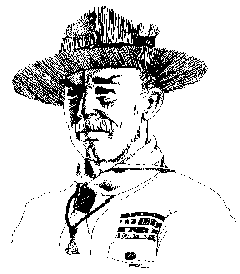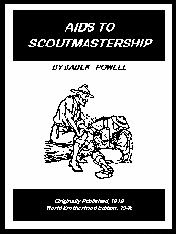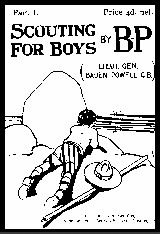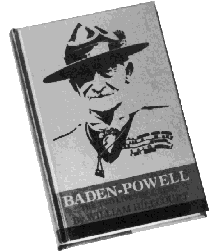Index

Index |
 |
Robert Stephenson Smyth Baden-Powell was born at 6 Stanhope Street (now 11 Stanhope Terrace), Paddington, London on February 22, 1857. He was the sixth son and the eighth of ten children of the Reverend Baden-Powell, a Professor at Oxford University. The names Robert Stephenson were those of his Godfather, the son of George Stephenson, the railway pioneer.
His father died when B.-P. was only three years old and the family were left none too well off. B.-P. was given his first lessons by his mother and later attended Rose Hill School, Tunbridge Wells, where he gained a scholarship for admittance to Charterhouse School. Charterhouse School was in London when B.-P. first attended but whilst he was there it moved to Godalming, Surrey, a factor which had great influence in his later life. He was always eager to learn new skills. He played the piano and fiddle. He acted - and acted the clown too at times. He practised bricklaying, and it was whilst a scholar at Charter house that he began to exploit his interest in the arts of Scouting and woodcraft.
Unofficially, in the woods around the school, B.-P. would stalk his Masters as well as catch and cook rabbits, being careful not to let the tell-tale smoke give his position away. His holidays were not wasted either. With his brothers he was always in search of adventure. One holiday they made a yachting expedition around the south coast of England. On another, they traced the Thames to its source by canoe. In all this, Baden-Powell was learning the arts and crafts which were to prove so useful to him professionally. B.-P. was certainly not a 'swot' at school, as his end of term reports revealed. One records: 'Mathematics - has to all intents given up the study', and another:
'French - could do well but has become very lazy, often sleeps in school'. Nevertheless, he gained second place for cavalry in open examination for the Army and was commissioned straight into the 13th Hussars, bypassing the officer training establishments, and subsequently became their Honorary Colonel for 30 years. His Army career was outstanding from the start. With the 13th Hussars he served in India, Afghanistan and South Africa and was mentioned in dispatches for his work in Zululand. There followed three years service in Malta as Assistant Military Secretary and then he went to Ashanti, Africa, to lead the campaign against Prempeh. Success led to his being promoted to command the 5th Dragoon Guards in 1897, at the age of 40. It was to the 5th Dragoon Guards that B.-P. gave his first training in Scouting and awarded soldiers reaching certain standards a badge based on the north point of thecompass. Today's Scout Membership badge is very similar.
In 1899 came Mafeking, the most notable episode in his outstanding military career, by which he became a Major-General at the age of only 43. B.-P. became famous and the hero of every boy, although he always minimised his own part and the value of his inspiring leadership. By using boys for responsible jobs during the siege, he learned the good response youth give to a challenge. During the 217 day siege, B.-P.'s book Aids to Scouting was published and reached a far wider readership than the military one for which it was intended. Following Mafeking, B.-P. was given the task of organising the South African Constabulary and it was not until 1903 that he returned to England as Inspector General of Cavalry and found that his book, Aids to Scouting'was being used by youth leaders and teachers all over the country. He spoke at meetings and rallies and whilst at a Boys' Brigade gathering he was asked by its Founder, Sir William Smith, to work out a scheme for giving greater variety in the training of boys in good citizenship.
B.-P. set to work rewriting Aids to Scouting, this time for a younger readership. In 1907 he held an experimental camp on Brownsea Island, Poole, Dorset, to try out his ideas. He brought together 22 boys, some from public schools and some from working class homes, and put them into camp under his leadership. The whole world now knows the results of that camp.
Scouting for Boys'was published in 1908 in six fortnightly parts at 4d a copy. Sales of the book were tremendous. Boys formed themselves into Scout Patrols to try out ideas. What had been intended as a training aid for existing organisations became the handbook of a new and, ultimately worldwide Movement. B.-P.'s great understanding of boys obviously touched something fundamental in the youth of this and other countries.
'Scouting for Boys' has since been translated into many different languages and dialects.
Without fuss, without ceremony and completely spontaneously, boys began to form Scout Troops all over the country. In September 1908, B.-P. had set up an office to deal with the large number of enquiries which were pouring in concerning the Movement.
There is no need to describe the way in which Scouting spread throughout the British Commonwealth and to other countries until it was established in practically all parts of the free world. Even those countries where Scouting as we know it is not allowed to exist readily, admit that they used its methods for their own youth training.
As Inspector-General of Cavalry, B.-P. considered that he had reached the pinnacle of his career. The baton of Field Marshal was within his grasp but he retired from the Army in 1910 at the age of 53, on the advice of His Majesty King Edward VII, who suggested that he would do more valuable service for his country within the Boy Scout Movement (now Scout Movement) than anyone could hope to do as a soldier!
So all his enthusiasm and energy was now directed to the development of Scouting and its sister Movement, Guiding. He travelled to all parts of the world, wherever he was most needed, to encourage their growth and give them the inspiration that he alone could give.
In 1912, he married Olave Soames who was his constant help and companion in all this work and by whom he had three children (Peter, Heather and Betty). Olave, Lady Baden-Powell, until she died in 1977, was known throughout the world as World Chief Guide.
The first international Scout Jamboree took place at Olympia, London in 1920. At its closing scene, B.-P. was unanimously acclaimed as Chief Scout of the World. Successive international gatherings, whether of Scouts or Rovers (now called Venture Scouts) or of Scouters, proved that this was not an honorary title, but that he was truly regarded by them all as their Chief. The shouts that heralded his arrival, and the silence that fell when he raised his hand, proved beyond any doubt that he had captured the hearts and imaginations of his followers in whatever country they owed allegiance.
At the 3rd World Jamboree, held in Arrowe Park, Birkenhead, to celebrate the 21st Anniversary of the publication of Scouting for Boys, the Prince of Wales announced that B.-P. had been created a Peer. He took the title of Lord Baden-Powell of Gilwell - Gilwell Park being the International Training Centre for Scout Leaders.
Scouting was not B.-P.'s only interest, for excelled at pig-sticking and fishing, and favoured polo and big game hunting. He was also a very good black & white and watercolour artist and took an interest in cinephotography and sculpture. In 1907, he exhibited a bust of John Smith, the colonial pioneer, at the Royal Academy.
B.-P. wrote no less than 32 books, the earning from which helped to pay for his Scouting travels. As with all his successors, he received no salary as Chief Scout. He received honorary degrees from Edinburgh, Toronto, Montreal, Oxford, Liverpool and Cambridge Universities. He also received Freedoms of the cities of London, Guildford,
Newcastle-on-Tyne, Bangor, Cardiff, Hawick, Kingston-on- Thames, Poole, Blandford, Canterbury and Pontefract, and of other cities in various parts of the world. In addition, 28 Foreign Orders and decorations and 19 Foreign Scout Awards were bestowed upon him. Every minute of B.-P.'s life was 'sixty seconds worth of distance run'. Each new adventure was the subject for a book. Every happy incident or thought, every fine landscape might be the subject for a sketch.
In 1938, suffering from ill-health, B.-P. returned to Africa, which had meant so much in his life, to live in semi-retirement in Nyeri, Kenya. Even here he found it difficult to curb his energies - he still produced many books and sketches.
On January 8, 1941, Baden-Powell died. He was 83 years of age. He is buried in a simple grave at Nyeri within sight of Mount Kenya. On his headstone are the words, 'Robert Baden-Powell, Chief Scout of the World' surmounted by the Boy Scout and Girl Guide Badges. His memory remains for all time in the hearts of millions of men and women, boys and girls.
It is up to those who are, or have been, Scouts or Guides to see that the two Movements he so firmly established continue for all time as living memorials to their Founder.
Towards the end of his life, although still in comparatively good health, he prepared a farewell message to his Scouts for publication after his death. It read:
"Dear Scouts - if you have ever seen the play 'Peter Pan' you will remember how the pirate chief was always making his dying speech because he was afraid that possible, when the time came for him to die, he might not have time to get it off his chest. It is much the same with me, and so, although I am not at this moment dying, I shall be doing so one of these days and I want to send you a parting word of goodbye.
Remember, it is the last time you will ever hear from me, so think it over. I have had a most happy life and I want each one of you to have a happy life too.
I believe that God put us in this jolly world to be happy and enjoy life. Happiness does not come from being rich, nor merely being successful in your career, nor by self-indulgence. One step towards happiness is to make yourself healthy and strong while you are a boy, so that you can be useful and so you can enjoy life when you are a man.
Nature study will show you how full of beautiful and wonderful things God has made the world for you to enjoy. Be contented with what you have got and make the best of it. Look on the bright side of things instead of the gloomy one.
But the real way to get happiness is by giving out happiness to other people. Try and leave this world a little better than you found it and when your turn comes to die, you can die happy in feeling that at any rate you have not wasted your time but have done your best. 'Be Prepared' i this way, to live happy and to die happy - stick to your Scout Promise always - even after you have ceased to be a boy - and God help you to do it.
Your friend,
![]()


"Books are like a gigantic treasure chest stuffed full of gold and precious stones and pieces of eight - and a bit of nonsense too. It is tremendous fun exploring the chest and deciding for yourself what is valuable and what isn't, what you want to keep and what you don't like."
--Baden-Powell, Wolf Cub Handbook(15th Edition), p. 162.
Books Index
Bibliography list adapted from Baden-Powell by William Hillcourt
 Books about Sir Robert Baden-Powell
Books about Sir Robert Baden-Powell
Back to Platinum Scout Website
Please help me to complete Scoutings history.
E-mail any comments, questions, information, or stories to:
faisal@faisalzulfiqar.cjb.net
Last update: January 6, 2000